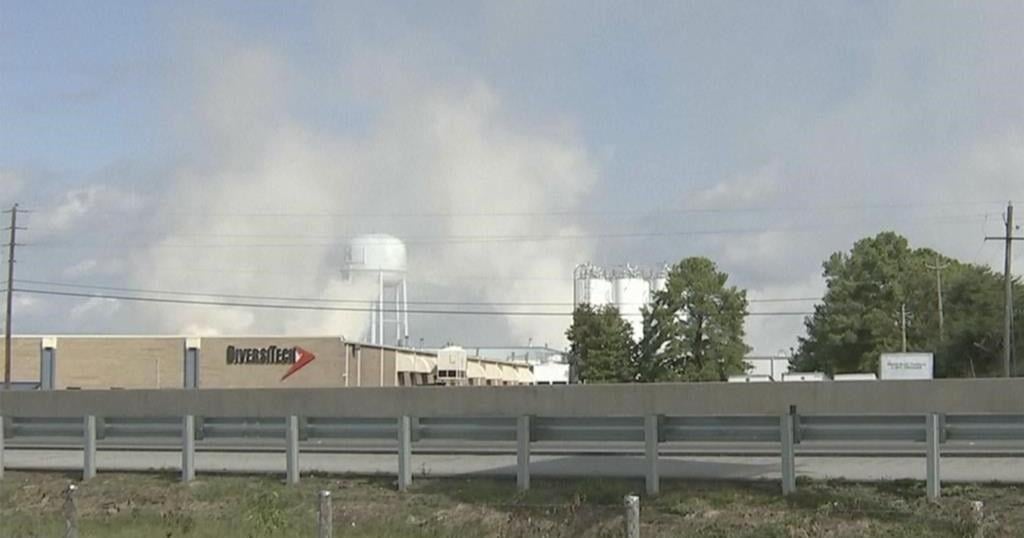CONYERS, Ga. – A weekend fire that sent a massive plume of dark smoke into the Georgia sky has led to complaints about a strong chemical smell and haze several miles away across metro Atlanta, where some schools canceled outdoor activities and residents living near the fire sheltered at home.
More than 90,000 people east of Atlanta were told to keep sheltering in place Monday, a day after the chemical plant fire.
The haze and chemical smell had spread to Atlanta by Monday, prompting firefighters to use detectors to check the air quality in various parts of the city, Mayor Andre Dickens said.
“We are sending investigators to the site to determine the cause of this dangerous incident and the safety gaps at the facility that allowed this huge fire to occur,” Steve Owens, chairman of the U.S. Chemical Safety and Hazard Investigation Board, said in a statement Monday. “Tens of thousands of people have been put potentially at risk by this catastrophe.”
Northeast of Atlanta, Arynne Johnson took her Great Danes outside in Suwanee on Monday morning when she encountered a foggy air that “slapped you in the face,” she recalled.
“I used to work at a water park, and it felt like walking into a pool house,” she said.
Closer to the source of the fire, officials said chlorine, a harmful irritant, had been detected in the air from the fire at the BioLab plant in Conyers, Georgia, the Rockdale County government said in a statement Monday. The plant is about 25 miles (40 kilometers) southeast of downtown Atlanta.
Who had to evacuate?
People in the northern part of Rockdale County, north of Interstate 20, were ordered to evacuate on Sunday, and others were told to shelter in place.
Sheriff’s office spokesperson Christine Nesbitt didn’t know the number of people evacuated, though it covered a large portion of the community of Conyers. Media reports said the number was about 17,000.
What should you do if you’re told to shelter in place?
The best practice for sheltering in place is to “turn the air conditioning off and keep windows and doors shut,” Rockdale County officials said.
Emergency management officials in Fulton County, which encompasses much of Atlanta, said people concerned about the haze or smell should follow the same advice: stay indoors, close their windows and doors and turn off the air conditioning.
Where else are people reporting concerns?
Residents of at least three large metro Atlanta counties — Fulton, DeKalb and Gwinnett counties — on Monday reported seeing a haze or the strong smell of chlorine.
In Atlanta, officials believe the hazy conditions and chemical smell is related to the BioLab fire, the Atlanta-Fulton County Emergency Management Agency said in a statement.
Employees were testing the air on Monday for chemicals including chlorine, hydrogen sulfide and carbon monoxide.
By early Monday afternoon, “no immediate life safety issues have been identified,” Atlanta Fire Rescue reported. Further testing was ongoing.
In Suwanee, Johnson said she got a headache, she’s been coughing and “my upper chest and throat have been tight all day.”
Later, on Monday afternoon, when she went to let the dogs out again, the air smelled like latex, but was not as strong as earlier, she said.
“I still don’t feel 100% normal,” she said Monday afternoon.
How are schools affected?
Georgia’s largest school system — Gwinnett County Public Schools — initially canceled all outdoor activities and events on Monday. School officials added that they’ve also taken steps to stop outside air from coming into its buildings. Monday afternoon, the school system reversed course, and said that after-school activities could be held.
The DeKalb County School District also announced that no after-school outdoor activities or athletics would take place Monday.
Closer to the fire, students in Rockdale County Public Schools were already out of the school for a fall break. In nearby Newton County, schools closed Monday, partly because of the large size of the evacuation zone.
What caused the fire?
The fire ignited when a sprinkler head malfunctioned around 5 a.m. Sunday at the BioLab plant in Conyers, Rockdale County Fire Chief Marian McDaniel told reporters. The malfunction caused water to mix with a water-reactive chemical, producing a plume of chemicals.
McDaniel said there were employees inside the plant, but no injuries were reported, The Atlanta Journal-Constitution reported.
The fire was brought under control around 4 p.m. Sunday, officials said.
What type of manufacturing plant is involved?
BioLab’s website says it is the swimming pool and spa water care division of Lawrenceville, Georgia-based KIK Consumer Products. The Conyers facility opened in 1973.
In May 2004, a huge fire in a warehouse at the Conyers complex set off multiple explosions and prompted the evacuation of 300 people as a chlorine-laden cloud rolled through the area, the Associated Press reported at the time. The plume of green, gray and white smoke stretched 10 miles (16 kilometers) long. At least nine people went to hospitals with complaints of burning eyes and lungs.
In June 2015, six Rockdale County firefighters were hurt in a fire at the complex, but none of the injuries were life-threatening, the Rockdale Citizen reported at the time. Another fire the following year prompted some voluntary evacuations near the plant, the newspaper reported.
In September 2020, a chemical fire at the same plant in Conyers prompted authorities to shut down both directions of Interstate 20 during morning rush hour. Inside the plant, BioLab workers used forklifts to try and move chemicals away from decomposing chemicals to prevent the catastrophe, but their forklifts were sliding on the wet floor and fumes of chemicals were forming. Firefighters’ access to the situation was hindered by poorly stacked pallets of materials, the Chemical Safety and Hazard Investigation Board later determined. Nine firefighters were evaluated at hospitals after inhaling hazardous vapors.
“Our top priority is ensuring the community’s safety, and our teams are working around-the-clock to respond to the ongoing situation at our facility in Conyers, Georgia,” a spokesperson said in a statement Monday. “We continue to work collaboratively with first responders and local authorities and have deployed specialized teams from out of state to the site to bolster and support their efforts. We are all focused on remediating the situation as rapidly as possible.”


































